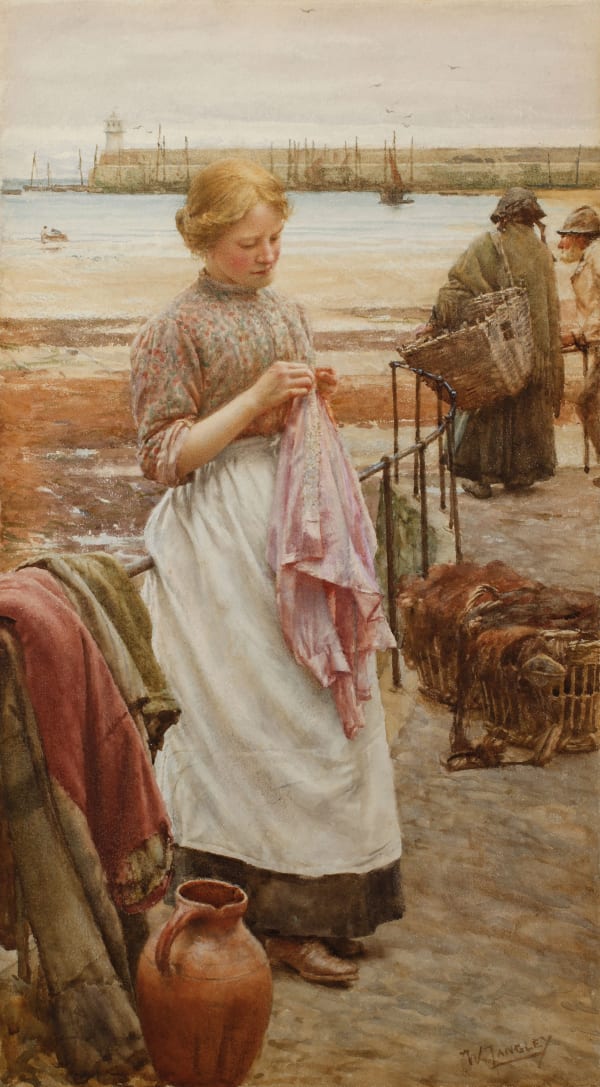Walter Langley 1852-1922
-
 Walter LangleyThe News, Newlyn Harbour, 1903Watercolour and body colour on paper59.5 x 43.8 cm (23 1/2 x 17 1/4 ins)
Walter LangleyThe News, Newlyn Harbour, 1903Watercolour and body colour on paper59.5 x 43.8 cm (23 1/2 x 17 1/4 ins)
Framed: 82.5 x 66.7 cm (32 1/2 x 26 1/4 ins)View full details -
 Walter LangleyThe Water Carrier, 1882Watercolour and body colour on paper54 x 35 cm (21 1/4 x 13 3/4 ins)
Walter LangleyThe Water Carrier, 1882Watercolour and body colour on paper54 x 35 cm (21 1/4 x 13 3/4 ins)
Framed: 74.3 x 55.2 cm (29 1/4 x 21 3/4 ins)View full details -
 Walter LangleyA Nautical Question, 1882Watercolour & Body colour on paper35.5 x 25.4 cm (14 x 10 ins.)
Walter LangleyA Nautical Question, 1882Watercolour & Body colour on paper35.5 x 25.4 cm (14 x 10 ins.)
Framed: 57.0 x 47.6 cm (22.4 x 18.7 ins.)View full details -
 Walter LangleyThe Marriage Column, c. 1900Watercolour & Body colour on paper48.3 x 27.9 cm (19 x 11 ins.)
Walter LangleyThe Marriage Column, c. 1900Watercolour & Body colour on paper48.3 x 27.9 cm (19 x 11 ins.)
Framed: 67.4 x 46.3 cm (26.5 x 18.2 ins.)View full details -
 Walter LangleyThe Pink Bodice, 1904Watercolour and Body colour on paper44 x 24 cm (17.3 x 9.5 ins)Sold
Walter LangleyThe Pink Bodice, 1904Watercolour and Body colour on paper44 x 24 cm (17.3 x 9.5 ins)Sold
Framed: 61 x 41.2 cm (24 x 16.2 ins)View full details
Walter Langley is one of the finest watercolourists the UK has ever produced, never mind of the Newlyn school, and certainly in his ability to capture the human form convincingly in that medium, he is unsurpassed. We had the privilege of celebrating Walter Langley in Channel 5's Watercolour Challenge. Penlee Gallery held a Walter Langley centenary retrospectuve exhibition in 2022.
Walter Langley was born on 8th June 1852 in Birmingham. At the age of 5 he entered the Hurst Street Unitarian Mission School, where 500 children were taught in two large rooms. Not an auspicious start but Walter showed an early acumen for drawing and painting which was spotted by the gifted head, W Wade. At the suggestion of Wade and financed by his mother who took in laundry to pay the tuppence a week required, Langley aged 11, started evening classes at Birmingham School of Design where he was to gather an impressive haul of prizes each year. In 1865, after an odd consultation with a Phrenologist that confirmed his suitability, he was apprenticed to the lithographer, AH Biermann. In 1873, whilst still working as a lithographer, Langley won a 2-year scholarship to the South Kensington Schools to study design, lodging in Godfrey Street in Chelsea. He revelled in the freedom to explore the South Kensington Museums, galleries, and West End theatres which he thoroughly enjoyed, recalling this period later as one of the happiest of his life. He also showed for the first time at the Royal Birmingham Society of Artists, 3 works in their Spring exhibition, and enjoyed his first trip to the southwest; a sketching tour in Devon.
In 1875 he entered into partnership with Biermann and the following year married Clara Perkins. The couple had a son, Lorraine and went on to have a daughter, Eleanor and two further sons, Gabriel and Cecil. The 3 years to 1878 were a frenetic period for Langley, with his daily lithographic work, evening art classes, painting and new family life.
In 1879, with a small group of contemporaries seeking to redress the imbalance in the established society exhibitions, which were dominated by an old guard, Langley founded the Birmingham Art Circle and from that year became a professional artist. Financially, life was challenging for an as yet unestablished artist; a vicious cycle of high output and low prices, particularly as dealers took an average cut of 40%. In his first professional year Langley sold 66 completed works to earn a sum of £288.
In 1880 Langley had his first visit to Newlyn; impressed by the painting opportunities this presented he followed this inaugural trip with a second visit a year later plus a trip to Brittany, heading for the outposts of Quimperle, Rennes and Pont Aven with Edwin Harris who described the colony as 'swarmed (with) English, French, Americans and representatives of almost all nationalities'. In 1882 he received an astonishing offer from Birmingham photographer and dealer, JW Thrupp working on behalf the Alldays family, for a commission of £500 (about £60,000 in today's terms, ref. Bank of England historic inflation calculator) for one year's work in Newlyn. Langley managed to negotiate an even better arrangement that would not require a full year's output but would earn him the offered remuneration, ultimately producing 43 paintings to fulfil the terms. This commission and Langley's income of £723 in 1881 from the sale of 102 paintings confirmed for him his future as an artist rather than lithographer.
In March 1882 Langley made the move to Newlyn taking up residence in Pembroke Lodge overlooking Mounts Bay and with south facing orchards (which provided a beautiful backdrop for some of his best-known paintings including 'The Sunny South'). He was the first artist of what was to become the Newlyn School, to settle in the fishing village and was thus and remains justly appraised, the Pioneer of the Newlyn Art Colony. His Thrupp commission complete, Langley's empathy and understanding of the poverty faced by Newlyn's fishing community started to find expression in his chosen subject matter. This effected a marked change in his work which his biographer and grandson, Roger Langley noted and described simply as social realism. Langley's social conscience and concern for those in need, and when fishing was poor the Newlyn community endured penurious times, was borne out in his political leanings which were Liberal, the progressive party of the period. He later became a friend of Charles Bradlaugh, a radical Liberal politician. Catherine Wallace has suggested in her lectures on Jules Bastien-Lepage that Langley was the only Newlyn artist who shared the French Realist's social conviction and genuine desire to convey social realist messages in his work.
Langley had a particular sensitivity towards women and the gender inequality and hardship that they endured; a plight often expressed in his artworks from this time onwards. The artist tested the waters of his new social realist approach sending some such watercolours to be exhibited in London's Dudley Gallery. One of these, 'Time moveth not, our being 'tis that moves', proved the highlight of the show and affirmed the new direction. In 1883 he was elected to the Royal Institute of Painters in Water Colour where he showed nine significant works from 1883 to 1891.
By 1883 there were 9 artists in the fledgling Newlyn community including Langley's co-pioneer, Edwin Harris and William Wainwright (although the latter left for a Paris Atelier shortly after). In 1884 a significant influx of 'colonisers' arrived; Fred Hall, Frank Bramley, Chevallier Tayler, Frank Richards, Henry Scott Tuke and of course most significantly, Stanhope Alexander Forbes. Significantly for Langley, all of these artists who were friends and associates but also competitors, were painters in oil. In 1923 Wainwright offered an explanation of Langley's choice of medium: " Why on his emergence from lithography and industrial design did Langley choose watercolour as his means of artistic expression, in preference to oil? It is a useful and pertinent question ... I am inclined in that decision to a distinct choice formed by personal preference and artistic conviction that for him it was the medium in which he could reach his highest expression."
Langley's Institute of Watercolours' exhibit of 1884, 'Among the missing', sold to a Manchester businessman for £420, quadrupling Langley's previous record for a single work. From there flowed a series of some of his greatest paintings; 'Departure of the Fleet' in 1886, the year he was also elected Associate Member of the IPO, 'Betrayed' (set in the Midlands) in 1887 - he purchased a Newlyn studio that same year, 'Village Idyll' in 1888 and 'Disaster! And O! For the touch of a vanish'd land' which won a Gold Medal for watercolours at the Paris Exhibition.
Langley built his reputation on these watercolour works but in 1892 he also exhibited his first oil painting at the Royal Academy, 'Sunlight and Shadow'. Prior to this he had actually shown oils at the Oil Painters Institute in 1883-1886 including 'The Sunny South' (Penlee Gallery and Museum) in 1885. In 1893 he had a one-man show at the Fine Art Society and won the Gold Medal for watercolours at World's Columbian Exposition in Chicago. In 1895 he painted 'Motherless' and was invited to donate a self-portrait to the Uffizi Gallery. It was despatched to Florence in 1897 and represented an honour that placed Langley in such salubrious company as Rembrandt, Raphael, and Velasquez not to mention the leading artists from his own homeland such as Millais, Rossetti and Holman Hunt. His first wife Clara, who had been a tremendous source of encouragement and support for the artist, suffered a stroke and died aged only 44 in 1895. That same year, Langley painted 'In faith and hope the world will disagree' which was cited by Tolstoy as example of good art in his essay 'What is Art?' In 1896 he set about 'Breadwinners', his largest ever work at 117cm x 216cm. Langley married Ethel Pengelly a few years later, a local Penzance girl and cousin of Harold Harvey. In 1898 they had a son John, the father of Langley's 1997 biographer, Roger Langley.
In 1903 he became an Honourary Associate of the Royal College of Arts. From 1904 Langley took a series of productive painting trips to Holland, basing himself in Volendam, a fishing village on the Zuider Zee and later travelling to Belgium. In 1911 he took part in the International Fine Arts Exhibition in Rome.
Walter Langley is one of the finest watercolourists the UK has ever produced, never mind of the Newlyn school, and certainly in his ability to capture the human form convincingly in that medium, he is unsurpassed. When looking at his greatest works, it is surely difficult not to marvel about how the artist could have achieved such monumental realism at all in his chosen medium, which is inherently more delicate and transparent. Moreover, although rarer, he was amongst the finest of the Newlyn artists in his oil works. Walter Langley died in Penzance on 22nd March 1922.
A century later, in February 2022, Mark Wilson of Cornish Masters had the privilege of talking about Walter Langley's achievements as a watercolour artist in Channel 5's Watercolour Challenge, Mounts Bay episode. From 25 May to 01 October 2022 the Penlee House Gallery and Museum held a centenary exhibition of Langley's work, 'Painting Between the Tides: Walter Langley (1852-1922)', drawn from Penlee's own works and collections from around the world including loans from Cornish Masters. The public gallery, which champions the Newlyn School of Painters, is located in Penzance and we strongly recommend a visit to any Walter Langley enthusiast.
Langley, Roger (2011) Walter Langley: from Birmingham to Newlyn, Samson & Company
Langley, Roger (1997) Walter Langley Pioneer of the Newlyn Art Colony, Samson & Company







